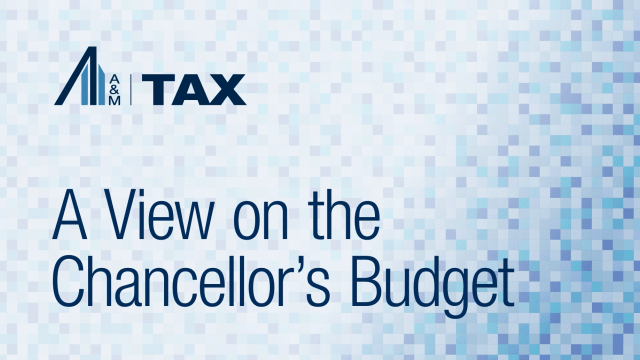Republican Blueprint May Violate International Trade Law and the Constitution — in a Single Bound
In a previous article in this series (Eye on Tax Reform: A&M Impact Series), we explained that the Republican Blueprint for Tax Reform, released this past July, proposes a new and different type of tax system that it describes as the “destination-based cash-flow tax” (DBCFT). The DBCFT would provide for so-called “border adjustments.” The border adjustments would consist of an exclusion for revenue from exports and the disallowance of any deductions (or other types of cost recovery) for the cost of imports. (See “Tax Reform: FX Rate Impact May Trump Tax Rate Impact.”)
In this edition, we discuss the possibility that the proposed border adjustments may violate international trade law as well as the Constitution. We also point out a few of the practical problems that may be associated with border adjustments in a direct tax system (as opposed to an indirect transaction tax system, like most VAT systems).
International Trade Law Concerns
In the fall of 1984, the firm Touche Ross & Co. sponsored a program that was open to the public at the World Trade Center in New York City to explain the then-recently enacted Foreign Sales Corporation (FSC) legislation. The FSC legislation was enacted to replace the Domestic International Sales Corporation (DISC) legislation, which was repealed in response to a determination that it was an illegal export subsidy under the General Agreement on Trade and Tariffs (GATT).
At that 1984 program, the late, great Eli Gerver, a renowned senior tax partner with Touche, opened up the festivities with some introductory remarks, the following of which were particularly notable in hindsight:
I’m here to tell you that two things are as certain as death and taxes:
1. The foreign sales corporation, like the DISC before it, will eventually be determined to be an illegal export subsidy; and
2. When that happens, we at Touche Ross will be right back here with a program to explain the FSC replacement legislation.
As history shows, Eli turned out to be correct on both counts. If Eli were still with us today, we are fairly sure that he would advise us that the export exclusion proposed in the Blueprint would (if enacted) also be determined to be an illegal export subsidy.
What We Learned About Illegal Export Subsidies From the DISC, FSC, ETI Controversies
The DISC regime was enacted in 1971. A DISC was a domestic corporation that satisfied certain formal requirements and that made an election to be treated as a DISC. DISC treatment allowed a deferral of tax (potentially indefinite) on a portion of the DISC’s taxable income from exports.
Shortly after the DISC regime’s enactment, certain trading partners of the U.S. that were signatories to the GATT challenged the DISC regime as an export subsidy that was prohibited by the GATT. In 1976, a GATT panel sustained those challenges, as well as U.S. challenges to certain export tax incentives provided by France, Belgium and the Netherlands. These rulings proved controversial and remained unadopted by the relevant signatory countries for a number of years. Finally, in 1981, without conceding that the DISC regime violated the GATT, the United States agreed to adopt the general findings of the GATT panel. And by 1984, we had the substantial(1) repeal of the DISC legislation, coupled with the enactment of the FSC legislation.
Eli Gerver passed away in 1997, about 13 years after his predictions (described above) and about one year before the first of those predictions began to come to fruition. In mid-1998, the EU brought a case against the FSC in the World Trade Organization (WTO), which had succeeded the GATT Secretariat in 1995. In 1999, a WTO panel agreed with the EU that the FSC regime constituted a prohibited export subsidy under the relevant WTO agreements; in early 2000, the WTO Appellate Body upheld that finding.
The WTO rulings held that the FSC rules constituted a subsidy because under the FSC rules the U.S. government refrained from collecting revenue that was “otherwise due.”(2) The rulings held that this subsidy was illegal because it was export-contingent. As Gerver predicted 16 years earlier, in an effort to comply with the WTO rulings, the United States repealed the FSC regime in late 2000 and enacted the Extraterritorial Income (ETI) regime.
Even before Congress enacted the ETI regime, the EU had already informed the United States that it intended to challenge that regime before the WTO. Two days after the President signed the FSC Repeal and Extraterritorial Income Exclusion Act of 2000 into law, the EU brought its case against the ETI regime in the WTO. In August of 2001, a WTO panel held that the ETI regime constituted a prohibited export subsidy under the relevant WTO agreements and the WTO Appellate Body later affirmed the panel’s findings.
The Appellate Body reviewed and upheld several of the panel’s findings, including the findings that the ETI legislation:
- involves the forgoing of revenue which is otherwise due and thus gives rise to a “financial contribution” (i.e., a subsidy);
- includes subsidies contingent on export performance;
- does not qualify for the exception from treatment as a prohibited export subsidy as a measure to avoid double taxation of foreign-source income;
- is inconsistent with other U.S. trade obligations because it accords less favorable treatment to imported products as compared with like products of U.S. origin;(3) and
- did not fully withdraw the FSC rules that were previously found to constitute a prohibited export subsidy (Congress had left the FSC provisions in place for transactions of existing FSCs for a long transition period).
Importantly, then, the ETI was held to be an unfair subsidy (points 1-3) and an impermissible discrimination against imports (point 4).
The U.S. Government was not immediately moved by the findings of the Appellate Body. But then in August 2002, a WTO arbitration panel ruled that the EU could impose trade sanctions of $4.04 billion (which was real money back in those days) against U.S. exports to the EU as a countermeasure to the prohibited export subsidy provided through the ETI Act. And then, yadda, yadda, yadda…, by 2004 the ETI provisions were repealed.
What the decades-long legal battle over the DISC, the FSC and the ETI has taught us is that (whether we agree with it or not), and regardless of any assumed economic effects, export subsidies delivered by means of an exemption in a direct tax system (which includes income tax systems) will be determined by the relevant international arbiter (the WTO Dispute Settlement Body) to be a violation of international trade laws.
Additional Insights From Mark Neville on Trade Law Considerations
It is important to note that in addressing U.S. tax reform proposals, we are in a space where there is an overlap between U.S. tax law, international trade law and economics. Mark Neville is an independent consultant with more than 30 years’ experienced on trade and customs matters. We are grateful to Mark for his insights in those areas, including the following:
- The GATT distinction on border tax adjustments is between direct and indirect taxes — this position goes back to at least 1970 in the GATT/WTO literature. The DISC, the FSC and the ETI were all declared as GATT-violating unfair subsidies because they dealt with exemptions of income tax, which are classed as “direct taxes.” Any thought that this dichotomy should not be the case and that exemption of direct (read: income) tax on exports should be permitted is just wishful thinking.
- As a result, it is essential to ascertain whether the DBCFT, a tax on “cash flow,” is a direct tax. If so, then we are looking at a subsidy claim, exactly in the DISC, FSC and ETI line. If not, we could be looking at a violation if the taxpayer receives more in credits than it paid, which some commentators have noted is possible under the Blueprint. Moreover, there is still the issue of discrimination against imports (noted at 6 below).
- The Blueprint and a recent report defending the use of border-adjusted income taxes, discussed in our second article in this series on tax reform, carefully avoid a definitive statement on this “direct vs. indirect tax” status point. That skirting of the issue does not make it go away. The criteria applied by the WTO Dispute Settlement Body are legal and not economic in nature — all the expostulations by economists Alan Auerbach and Douglas Holtz-Eakin, or Martin Feldstein, that the subsidy effect of the tax regime is obviated by exchange control movements, will avail nothing in that analysis if the DBCFT is classed as a direct tax. A prima facie violation is made out with a showing of an infringement of a WTO obligation.
- Any review or analysis of the DBCFT should be and assuredly will be undertaken by the WTO with a rigorous analysis of the tax regime in light of the specific terms of the GATT and other WTO Agreements.
- Apart from the export subsidy issue, there is the real risk that the DBCFT will be found to discriminate against imports. Disallowing a deduction for the price paid for an imported article while allowing a deduction for a domestic article is a separate basis for a finding of a violation, regardless of whether the disallowance is styled a “border adjustment.” Depending on the status of the DBCFT, as a direct or an indirect tax, there is at least one and there are possibly two separate violations of the obligations to refrain from discriminating against imports imposed by Arts. III.2 and III.4 of the GATT 1994. Note: the WTO has held that even a risk of discrimination is itself a discrimination.
Potential Constitutional Infirmity of the Border Adjustment on Imports
The Blueprint does not provide any indication that its drafters even considered the possibility that the border adjustment for imports might violate the Constitution. That may be due to a natural inclination to think of the inbound border adjustment as being in the nature of an import tariff. It is common knowledge that import tariffs are permissible under the Constitution and that they were once a fairly large revenue source for the U.S. Government.
It is also commonly understood among both tax lawyers and constitutional lawyers that the federal power to tax is almost entirely without any constitutional limitations. Nonetheless, it is critical to understand that the Constitution does impose some very clear limitations on the federal taxing power. It’s just that those limitations seldom come into play. But it just so happens that the DBCFT appears to implicate one of those limitations.
While the inbound border adjustment may be the economic equivalent of an import tariff, it is critical to understand that it is not the constitutional equivalent. In constitutional parlance, an import tariff is an indirect tax (i.e., a tax that is not imposed directly on persons, but rather that is imposed on, and thereby built into the cost of, a transaction). In contrast, as a matter of constitutional law, it appears highly likely that the DBCFT would be determined to be a direct tax (i.e., a tax that is imposed directly on persons).
Article I, section 8 of the Constitution provides (in relevant part) that “the Congress shall have the power to lay and collect taxes, duties, imposts and excises.” Section 9 then goes on to provide (in relevant part) that “No capitation, or other direct, Tax shall be laid, unless in Proportion to the Census or Enumeration herein before directed to be taken.” Since an import duty is an indirect tax, it is not subject to the prohibition in section 9.
The 16th Amendment superseded the prohibition in section 9 for direct taxes, but only as that prohibition applies to income taxes. The Supreme Court has determined that a tax on gross sales proceeds, with no allowance for the recovery of the tax basis of the goods sold, is not an income tax. Therefore, if a tax on gross sales proceeds does not qualify as an indirect tax, it would violate Article I, section 9, unless apportioned among the states in proportion to their populations.
The proposed border adjustment for imports would have the result that resellers of imported products would be taxed on their gross sales proceeds, with no allowance for the recovery of the tax basis of the goods sold. As a result, a significant portion of the tax revenue collected from the DBCFT would be from a direct tax that is not an income tax. Therefore, unless the tax burden resulting from the proposed border adjustment on imports is apportioned among the states (which is not presently proposed and is unlikely to become the case with the DBCFT), this aspect of the DBCFT would appear to violate Article I, section 9 of the Constitution.
Practical Concerns
The fact that border adjustments seem to fit well in indirect tax systems (i.e., transaction tax systems, like most VAT systems) does not mean that they can be practically applied in a direct tax system, like the current U.S. income tax or the proposed DBCFT.
Potential for Cascading Effects of the Border Adjustment on Imports
In an indirect tax system (e.g., a VAT or an import tariff), the border adjustment on imports occurs one time, at the border (or when the product or service is purchased when it first crosses the border). Even though the product or service retains its character as having been produced outside the U.S., subsequent transfers of the product or service occurring inside the U.S. are not subjected to additional tariffs or VATs on the same value.
In the case of a direct tax, like the DBCFT, the tax is not imposed on a transaction when it occurs at the border. It is imposed on U.S. taxpayers who purchase products or services produced outside the U.S. One question the Blueprint does not address is whether, and if so how, the DBCFT will prevent a cascading effect of its inbound border adjustments in the case of products or services that are transferred through multiple levels of commerce.
For example, let’s say that today we have a company in Mexico (not a U.S. taxpayer) that makes a product that is sold to a distributor in the U.S. for $100, and the distributor sells the product to a wholesaler for $110, and the wholesaler sells the product to a retailer for $130, and the retailer sells the product to a consumer for $200. If the U.S. imposed a 20 per cent tariff, the tariff would be a one-time event and the amount of the tariff would be $20. In contrast, under the DBCFT, unless the border adjustment includes some kind of mechanism to prevent cascading border adjustments, the following would occur:
- The distributor would have $110 of taxable cash flow and would lose $10 after tax (instead of making $6.50 after tax under present law.
- The wholesaler would have $130 of taxable cash flow and would make $4 after tax (instead of making $13 under present law).
- The retailer would have $200 of taxable cash flow and would make $30 after tax (instead of making $45.50 under present law).
- In total, there would be border adjustments of $68 ($20+$22+$26), instead of $20 if there were a mechanism to prevent cascading.
Identification of Imported Products
For the border adjustment on imported products to work effectively, it would seem that there will have to be some kind of mechanism to put U.S. purchasers on notice as to whether the product they are purchasing was produced outside or inside the U.S. That may not always be apparent. For example, a foreign vendor may be selling a product that was produced in the U.S., or a U.S. vendor may be selling a product that was produced outside the U.S. A vendor may be selling a product that was produced in the U.S. using imported components, or vice versa.
To prevent the cascading effect described above, it will be necessary for the DBCFT system to somehow allow U.S. taxpayers who purchase an imported product to establish that another U.S. taxpayer has already been denied a deduction (or other form of cost recovery) for that product.
Identification of Imported Services
It would seem that the identification issues discussed above for products may be even more difficult to deal with in the case of services. It may be possible to stamp a label on a product that identifies its country of origin. Not so with a service.
So it will presumably be the burden of the taxpayer to establish that the service it is procuring was performed in the U.S. If it cannot do so, then presumably it will have a legal obligation to refrain from claiming a tax deduction or any other form of cost recovery for the service in question.
Service providers (whether inside or outside the U.S.) may be tempted to inform their U.S. customers that their services are performed in the U.S., even if they are actually performed elsewhere. It may be challenging to enforce a reporting obligation on service providers, especially those that may not have a fixed place of business in the U.S.
Services that are performed partly in the U.S. and partly outside the U.S. may present additional compliance challenges.
Dealing With Fungible Products or Services
If a vendor sells a product that is fungible, with some inventory of U.S. origin and some of foreign origin, there will have to be some kind of mechanism to require the purchaser to establish whether the product being purchased was produced inside or outside the U.S. Here again, there may be a real challenge in imposing an identification and reporting obligation on vendors, especially foreign vendors.
This concern may be even more difficult with fungible services. For example, how would the identification and reporting rules be crafted to address call center services or cloud services provided by a vendor that has service centers both inside and outside the U.S.? What is to prevent the vendor from telling U.S. customers that the services they received were performed at a U.S. service center?
Compliance Issues With Exports
Under the DBCFT, U.S. taxpayers would receive a substantial tax benefit (i.e., a complete exemption) for export revenues. Presumably, the DBCFT will have to impose a requirement on the taxpayer to establish that its product or service sold was, in fact, exported. With tangible products, that may not be a problem in most cases. With services (especially those performed remotely), there may be many situations where it is impractical or impossible to establish where the service was received.
These are just a few of the more obvious practical problems with border adjustments in a direct tax system. Presumably there would be other less obvious ones that would surface if and when the DBCFT is enacted.
Alvarez & Marsal Taxand Says:
There appears to be a real possibility that the border adjustments proposed in the Blueprint would eventually be determined to violate international trade law, as well as the U.S. Constitution. In addition, there are some obvious (and probably some not so obvious) practical problems associated with border adjustments in a direct tax system. Nonetheless, the recent political climate change could make way for the adoption of border adjustments in the U.S. tax system, regardless of any such risks or challenges.
As we mentioned in a prior edition, regardless of whether border adjustments are included in tax reform legislation, it appears likely that tax reform could have a number of significant effects on the value of the U.S. dollar. So, in addition to modeling out the impact of tax reform on your company’s effective tax rate, it may also be prudent for you to model out the impact of a few selected assumptions in regard to the impact of tax reform on FX rates, as we have done for some of our clients.
Coming Up Next
In upcoming editions of the Eye on Tax Reform: A&M Impact Series, we will:
- challenge the assertion of several respected economists that border adjustments would be trade neutral; and
- explain why the border adjustments in most VAT systems are not illegal export subsidies.
- A revised and greatly reduced DISC benefit was left on the books for so-called “interest-charge DISCs.” For an explanation of the interest-charge DISC, see Lee, You Must Remember This: A DISC Is Not a DISC, Its Fee Is But a Lie, 2015 TNT 184-8.
- For these purposes, the Agreement on Subsidies and Countervailing Measures (SCM) generally defines a subsidy as a foregoing of government revenue that is otherwise due, under Art. 1.1(a) (1) (ii). Subsidies contingent upon export performance are specifically prohibited, under Art. 3.1 (a). The WTO did not examine whether the FSC was in violation of 3.1 (b) of the SCM, which prohibits subsidies contingent on the use of domestic over imported goods.
- Mark Neville, Principal of the law firm International Trade Counsellors, notes that the ETI unfairly discriminated against imports since the FSC rules included a regime that required 50 percent domestic content. Specifically, this violated Art. III.4 of the GATT 1994 requirement of “national treatment” for imports.
Disclaimer
The information contained herein is of a general nature and based on authorities that are subject to change. Readers are reminded that they should not consider this publication to be a recommendation to undertake any tax position, nor consider the information contained herein to be complete. Before any item or treatment is reported or excluded from reporting on tax returns, financial statements or any other document, for any reason, readers should thoroughly evaluate their specific facts and circumstances, and obtain the advice and assistance of qualified tax advisors. The information reported in this publication may not continue to apply to a reader's situation as a result of changing laws and associated authoritative literature, and readers are reminded to consult with their tax or other professional advisors before determining if any information contained herein remains applicable to their facts and circumstances.
About Alvarez & Marsal Taxand
Alvarez & Marsal Taxand, an affiliate of Alvarez & Marsal (A&M), a leading global professional services firm, is an independent tax group made up of experienced tax professionals dedicated to providing customized tax advice to clients and investors across a broad range of industries. Its professionals extend A&M's commitment to offering clients a choice in advisors who are free from audit-based conflicts of interest, and bring an unyielding commitment to delivering responsive client service. A&M Taxand has offices in major metropolitan markets throughout the U.S., and serves the U.K. from its base in London.
Alvarez & Marsal Taxand is a founder of Taxand, the world's largest independent tax organization, which provides high quality, integrated tax advice worldwide. Taxand professionals, including almost 400 partners and more than 2,000 advisors in 50 countries, grasp both the fine points of tax and the broader strategic implications, helping you mitigate risk, manage your tax burden and drive the performance of your business.
To learn more, visit www.alvarezandmarsal.com or www.taxand.com







